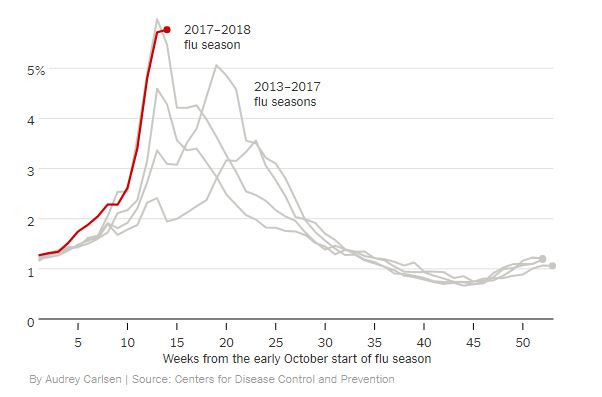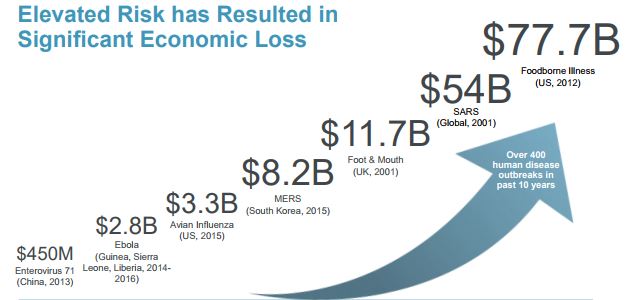“It’s pretty much 100% accepted.”
Those aren’t the words you want to hear from a leading epidemiologist predicting a second coming of the deadliest flu pandemic in modern history. And this time around, the damage will be much, much greater.
CRI sat down with Patrick Ayscue, director of epidemiology at Metabiota, to talk about the current flu strain that has staff grabbing the Kleenex left right and centre in an office near you, but the infectious disease expert was quick to shift attention to flu seasons yet to come.
“This is definitely a bad flu season,” Ayscue says. “It’s one of the worst ones we’ve seen in the last ten years or so, but actually 2014-2015 at this point was a bit worse.” What’s clouding our perception of the severity, he says, is the fact that this year’s flu season started earlier than normal.
2017-2018 flu season slightly more severe than recent years
Percentage of outpatient visits for flu-like symptoms highest in five years

Luckily, we’re nearly through the worst of it for this year, with surveillance modelling predicting peak infection within a week or two. In all, this year’s H3Nz strain has caused a moderately severe season, according to the CDC.
“[Influenza] is a very serious disease, and we see a lot of impact from it annually,” says Ayscue, “but it’s something we expect every year. Really where a lot of the uncertainty comes from are more of these black-swan events that can result in pandemics. That’s something a lot of companies have not prepared for.”
The likelihood a global influenza pandemic the likes of 1918’s Spanish flu cropping up again is virtually undisputed. 100 years ago, the strain infected an estimated 500 million people worldwide and killed 20-50 million. 25% of people in the US alone were infected.
But the world is a much different place to what it was in 1918, and for all our advances, we find ourselves at a much greater risk of pandemic disaster than ever before. “One of the implications of a better-connected world is that when we do see these influenza pandemics, they’re going to have the ability to spread farther, faster,” says Ayscue. “More people are going to be impacted before we have a full response in place.”
It takes about six months to produce a vaccine for a known strain of the flu. That’s much more time than a virus would need to spread its way to most corners of today’s mobile population, which is why scientists, corporate leaders and governments alike are seeing ever-higher costs of infectious disease events.
 Source: Petra Wildemann, Metabiota
Source: Petra Wildemann, Metabiota
If the 1918 Spanish influenza virus event were to happen today, Metabiota’s modelling predicts:
- 2.9 billion non-fatal infections
- 8.9 million deaths
- US$36.8bn in life-insurance losses
In the US alone, Metabiota would expect to see 109 million infections, 184,600 deaths and over US$17bn in life insurance losses. Worker absenteeism rates would peak at about 12%, with the health services sector most heavily impacted.
“It’s not really a question of if there’s going to be another flu pandemic like the 1918 flu, but when,” says Ayscue, “and more people are going to be impacted before we have a full response in place.”
Related stories:
The price of public health: Assessing epidemic risk management
When, not if: Are you prepared for pandemic risk?

.jpg)


